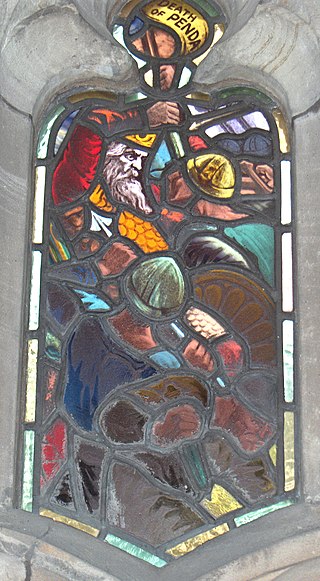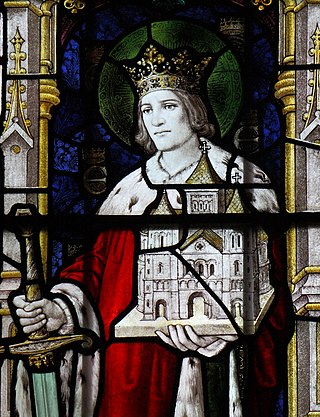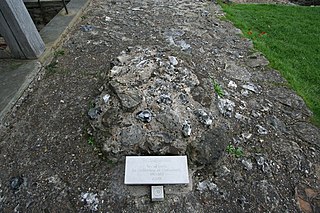Related Research Articles

Mercia was one of the three main Anglic kingdoms founded after Sub-Roman Britain was settled by Anglo-Saxons in an era called the Heptarchy. It was centred on the River Trent and its tributaries, in a region now known as the Midlands of England.

Penda was a 7th-century king of Mercia, the Anglo-Saxon kingdom in what is today the Midlands. A pagan at a time when Christianity was taking hold in many of the Anglo-Saxon kingdoms, Penda took over the Severn Valley in 628 following the Battle of Cirencester before participating in the defeat of the powerful Northumbrian king Edwin at the Battle of Hatfield Chase in 633.

Edwin, also known as Eadwine or Æduinus, was the King of Deira and Bernicia – which later became known as Northumbria – from about 616 until his death. He converted to Christianity and was baptised in 627. After he fell at the Battle of Hatfield Chase, he was venerated as a saint.

The Battle of the Winwaed was fought on 15 November 655 between King Penda of Mercia and Oswiu of Bernicia, ending in the Mercians' defeat and Penda's death. According to Bede, the battle marked the effective demise of Anglo-Saxon paganism.

The Battle of Maserfield, a corruption of the Welsh Maes Elferth was fought on 5 August 641 or 642 between the Anglo-Saxon kings Oswald of Northumbria and Penda of Mercia allied with Welsh Kingdom of Gwynedd, ending in Oswald's defeat, death, and dismemberment. The location was also known as Cogwy in Welsh, with Welshmen from Pengwern participating in the battle, probably as allies of the Mercians. Bede reports the commonly accepted date given above; the Welsh Annales Cambriae is generally considered incorrect in giving the year of the battle as 644. The site of the battle is traditionally identified with Oswestry.
Dumnonia is the Latinised name for a Brythonic kingdom that existed in Sub-Roman Britain between the late 4th and late 8th centuries CE in the more westerly parts of present-day South West England. It was centred in the area of modern Devon, but also included modern Cornwall and part of Somerset, with its eastern boundary changing over time as the gradual westward expansion of the neighbouring Anglo-Saxon kingdom of Wessex encroached on its territory. The spelling Damnonia is sometimes encountered, but that spelling is also used for the land of the Damnonii, later part of the Kingdom of Strathclyde, in present-day southern Scotland. The form Domnonia also occurs. The name of the kingdom shares a linguistic relationship with the Breton region of Domnonée.

Cadwaladr ap Cadwallon was king of Gwynedd in Wales from around 655 to 664 or 682. He died in one of two devastating plagues that happened in 664 and in 682. Little else is known of his reign.

Cadwallon ap Cadfan was the King of Gwynedd from around 625 until his death in battle. The son and successor of Cadfan ap Iago, he is best remembered as the King of the Britons who invaded and conquered Northumbria, defeating and killing its king, Edwin, prior to his own death in battle against Oswald of Bernicia. His conquest of Northumbria, which he held for a year or two after Edwin died, made him one of the last recorded Celtic Britons to hold substantial territory in eastern Britain until the rise of the Welsh House of Tudor. He was thereafter remembered as a national hero by the Britons and as a tyrant by the Anglo-Saxons of Northumbria.

The Battle of Hatfield Chase was fought on 12 October 633 It pitted the Northumbrians against an alliance of Gwynedd and Mercia. The Northumbrians were led by Edwin and the Gwynedd-Mercian alliance was led by Cadwallon ap Cadfan and Penda. The site of the battle was a marshy area about 8 miles (13 km) northeast of Doncaster on the south bank of the River Don, though this location has been disputed. It was a decisive victory for Gwynedd and the Mercians: Edwin was killed and his army defeated, leading to the temporary collapse of Northumbria.
Cadafael was King of Gwynedd. He came to the throne when his predecessor, King Cadwallon ap Cadfan, was killed in battle, and his primary notability is in having gained the disrespectful sobriquet Cadafael Cadomedd.
Cearl was an early king of Mercia who ruled during the early part of the 7th century, until about 626. He is the first Mercian king mentioned by Bede in his Historia ecclesiastica gentis Anglorum. Bede was a Northumbrian who was hostile to Mercia, and historian Robin Fleming speculates that as "ceorl" means "rustic" in Old English, his name may have been a joke.
Cadfan ap Iago was King of Gwynedd. Little is known of the history of Gwynedd from this period, and information about Cadfan and his reign is minimal.
Iago ap Beli was King of Gwynedd. Little is known of him or his kingdom from this early era, with only a few anecdotal mentions of him in historical documents.
The Battle of Chester was a major victory for the Anglo-Saxons over the native Britons near the city of Chester, England in the early 7th century. Æthelfrith of Northumbria annihilated a combined force from the Welsh kingdoms of Powys and Rhôs, and possibly from Mercia as well. It resulted in the deaths of Welsh leaders Selyf Sarffgadau of Powys and Cadwal Crysban of Rhôs. Circumstantial evidence suggests that King Iago of Gwynedd may have also been killed. Other sources state the battle may have been in 613 or even as early as 607 or 605 AD.
The Timeline of conflict in Anglo-Saxon Britain is concerned with the period of history from just before the departure of the Roman Army, in the 4th century, to just after the Norman Conquest in the 11th century.
Cuthwulf, also sometimes Cutha, was the third son of Cuthwine, and consequently a member of the House of Wessex. Although a member of the direct male line from Cynric to Egbert, Cuthwulf was never king. He is said to have been born circa 592, and his death date is unknown.

Events from the 7th century in England.
Clemen ap Bledric was a 7th-century King of Dumnonia.
Urbs Iudeu was a city, whose location is now unknown, which according to the ninth-century Historia Brittonum was besieged in 655 AD by Penda, King of Mercia, and Cadafael, King of Gwynedd.
References
- ↑ Jenkins, Alexander. The History and Description of the City of Exeter. P. Hedgeland. 1806 p11
- ↑ Giles, J. A. Six Old English Chronicles. Henry G. Bohn. 1848 p284
- ↑ Oliver, Rev. George (1861). The History of the City of Exeter. Exeter: William Roberts. p. 12.
- ↑ Freeman, Edward. A. (1887). Historic Towns: Exeter. London: Longmans, Green, and Co. p. 15.